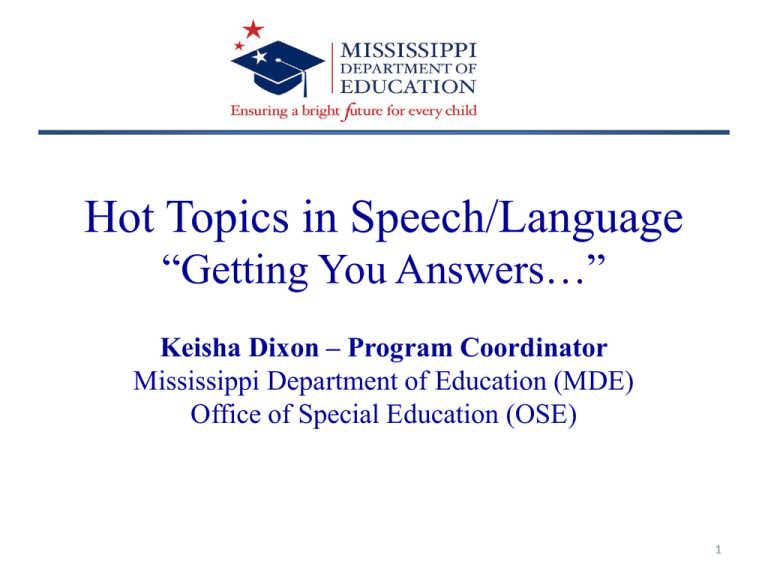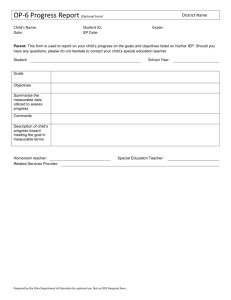Revised MSHA's Presentation - Mississippi Department of Education
advertisement

Hot Topics in Speech/Language “Getting You Answers…” Keisha Dixon – Program Coordinator Mississippi Department of Education (MDE) Office of Special Education (OSE) 1 State Board of Education Vision To create a world-class educational system that gives students the knowledge and skills to be successful in college and the workforce, and to flourish as parents and citizens Mission To provide leadership through the development of policy and accountability systems so that all students are prepared to compete in the global community 2 State Board of Education Goals 5-Year Strategic Plan for 2016-2020 All Students Proficient and Showing Growth in All Assessed Areas Every Student Graduates High School and is Ready for College and Career Every Child Has Access to a High-Quality Early Childhood Program Every School Has Effective Teachers and Leaders Every Community Effectively Using a World-Class Data System to Improve Student Outcomes 3 Alignment of Training to Strategic Plan This training is designed to provide participants with answers concerning the implementation of the new IEP document. Participants will discuss the new progress monitoring system and how to identify and intervene early when a student is not progressing toward measurable annual goals. In addition, participants will align the development of measurable annual goals to MS College and Career Readiness Standards. 4 Getting You Answers for “Annual Review Date…” 34 C.F.R. § 300.323 When must IEPs be in effect? IEPs must be in effect at the beginning of each school year. 300.324 (b)(1)(i) The IEP Committee reviews the child’s IEP periodically, but not less than annually… 5 Getting You Answers for “Annual Review Date…” An example of the annual review date: Annual Review Date – 04.10.2015 Review of the IEP no later than annually – 04.10.2016 Services begin – 08.10.2015 Services end – 05.21.2016 IEP Meeting Date – 04.10.2015 Projected Date for Review – 04.10.2016 6 Getting You Answers for “Special Considerations…” How do you address Special Considerations for Communication and Assistive Technology? • What are the communicative demands and opportunities for the child? • Does the child have the skills/strategies needed to meet the demands communicatively? • Can the child fulfill his/her needs to communicate in different settings? • Does the child communicate appropriately and effectively? If not, why? • How are the communication needs described? 7 Getting You Answers for “Communication…” Does the child communicate appropriately and effectively? Sean is unable to communicate appropriately and effectively without the assistance of an SLP to address his communicative needs that involve goals for fluency of speech. Without fluency goals and objectives utilized in a variety of educational settings, his disability would continue to impact him socially and vocationally, which will prevent him from college and career readiness, and achieving his post-secondary goal of being an EMT. DATA: Formal assessment severity instruments; informal conversational S/L samples; classroom observations; parent input; student input; teacher input… 8 Getting You Answers for “Assistive Technology…” • Does the child require assistive technology assessment to ascertain benefit? • What types of assistive technology might increase the child’s participation in the general education curriculum (or developmentally appropriate activities)? • Is the child currently using any assistive device or service? If so, does the child’s AT device work? 9 Getting You Answers for “Assistive Technology…” Does the child require assistive technology assessment to ascertain benefit? Addison has been considered for assistive technology to address the required components of her IEP; however, with her articulation disorder, she doesn't demonstrate any skill tasks that she cannot perform orally or within her cognitive ability. She doesn’t need the use of any voice output or voice recognition devices; therefore, it has been determined by the IEP Committee that she doesn’t need an assistive technology assessment or device. DATA: Oromotor examination; formal/informal assessments; classroom observations; parent / teacher / student input… 10 Getting You Answers for “Consultative Services …” Can we count students that are receiving collaborative/consultative services? No. Students receiving collaborative/consultative services must receive direct services[specially designed instruction – SDI] from the speech language pathologist (SLP). The collaborative/consultative approach does not replace the direct services provided to student. 11 Getting You Answers for “Dismissal…” 1. When do I dismiss a student from language/speech services? Students should be dismissed from language/speech therapy when they meet one of the following criteria: • they no longer have a disability; and/or • they no longer require language/speech services due to their disability. 12 Getting You Answers for “Dismissal…” 2. What are the procedures for dismissal from language/speech services? • Review the IEP. • Review current data to determine adverse educational impact. • Administer assessment/ evaluation when appropriate. • Interview the teachers, parents and therapists. • Conduct observations in a variety of setting. 13 Getting You Answers for “Dismissal…” 3. The IEP Committee can determine if language/speech services are no longer warranted for the following reasons: • The student has mastered IEP goals/objectives. The SLP needs to assess the student’s progress on the IEP for documentation. • The student’s language/speech skills are within normal range in a variety of settings-school, home, etc. • The student has plateaued or shown a lack of progress. Be careful with this situation. There must be documentation to support the lack of progress shown on the IEP’s report of progress. Documentation of the lack of progress must be included in the reevaluation for dismissal and shall include all the components of a comprehensive evaluation which involves the parent, the general education teacher, reviewing academic performance, etc. 14 Getting You Answers for “Dismissal…” The IEP Committee can determine if language/speech services are no longer warranted for the following reasons: • When an SLP considered documenting the student’s lack of progress, the following should be taken into account: if the student has limited physical, mental, or emotional ability to self-monitor communication, poor attendance, lack of motivation and limited potential for a significant change in communication skills. • The student’s communication no longer has an adverse educational impact on educational, social/behavior or vocational performance. • The student no longer requires language/speech services due to their disability. Skills can be monitored and maintained in the student’s environment (i.e., special education teacher, general education teacher, etc.). 15 Getting You Answers for “Dismissal…” • Please remember the IEP Committee must determine if the student is no longer in need of specially designed instruction (SDI) and related services. A full and formal evaluation is not always needed. The IEP Committee may decide the current performance or assessment data and the IEP progress provides enough information to make a decision regarding dismissal. Lastly, remember a reevaluation report is required for dismissal from language/speech services to document a student is no longer eligible for special education services for any reason, including mastery of goals. 16 Getting You Answers for “Expectation Statement …” What is the additional statement written within the Impact of Disability and Child Needs section of the IEP? • All SLPs will write an “Expectation Statement” that defines what students should have achieved from a language/speech communicative aspect by age and/or grade that is connected to the Standards, and then addressed within the PLAAFP of the “Impact of the Disability and Child Needs” section of the IEP. http://www.asha.org/public/speech/development/kindergarten.htm • The Impact statement and Child Needs statement will address the adverse educational impact, and describe the skills needed to be successful in the general education curriculum. 17 Expectation & Impact Statement for the PLAAFP • Expectation Statement Most kindergartners by the age of five at this point in the school year (according to formal and informal assessments) have acquired certain social and language skills to help enhance their ability to communicate, and interact with peers and teachers. Kindergartners typically are able to listen to short stories and recall simple details of the story, follow simple verbal directions given by teachers, answer simple questions and ask questions of others, as well as respond to a number of ‘wh questions’. L.K.1.d Impact Statement E’Class Mercedes recognizes her name in print, talks to other children, counts orally to ten (10), names primary colors and one secondary color (green), but she consistently exhibits difficulty with answering and asking questions appropriately, and retrieving information from short stories read with details, and these skill deficits in expressive language adversely affect her ability to effectively communicate academically and socially. 18 Getting You Answers for “Measurable Annual Goals and STIOs…” When are the measurable annual goals and STIOs connected to the Mississippi College and Career Readiness Standards? When the IEP Committee determines the the S/L deficits are academic in nature, i.e., connected to (Reading) English Language Arts (ELA), then the Standards are attached to the deficits on the student’s present grade level. The STIOs are written on the student’s instructional/functional level(s). Measurable annual goals may be written as (for example): Within 36 weeks, Gary will… By the end of the school year, Mary Margaret will… By May of 2016, Kyleigh will… 19 Measurable Annual Goal (Artic) 1st Grade With no more than 2 prompts, Camry Avalon will orally produce the target phoneme of /r/ and /rblends/in words [initial and medial] and blending for 100% accuracy during a five minute conversational sample with teachers and peers within the general education setting within 36 weeks. RF.1.2.b. Condition: During conversation with no more than 2 prompts Behavior: Camry Avalon will orally produce the phoneme and blends Criteria:100% (during 5 minutes) Timeframe: Within 36 weeks. 20 Getting You Answers for “MAGs and STIOs Not Connected to the Standards…” How are measurable annual goals written if not connected to the Standards? If the IEP Committee determines the student’s deficits are not academic in nature, i.e., the deficits have a “functional” impact (social, emotional, and/or vocational), then the goals are written in the traditional fashion, but maintaining the components of measurability. (MAG) By the end of the 2016 school year, Gareth will use appropriate resonation in spontaneous conversational speech with no more than two nasal/oral substitutions for 90% accuracy outside the therapy setting. (STIO 1): When given consonant-vowel syllables, Gareth will demonstrate correct placement of the articulators produced in imitation by the SLP with no facial grimacing or distorting for 80% accuracy during the first 9-weeks. 21 Getting You Answers for “Frequency and Duration of Services…” • How do we record how often a student is seen for speech and/or language therapy, i.e., (articulation, language, voice, and/or fluency)? • Specific amounts of time are recorded as: (Example): 3-days per week / 45 min. each day. SLPs will no longer use minutes per month or minutes per nine weeks, etc. 22 Report of Progress Sufficient ROI = (Outcome Behavior Rate - Baseline Behavior Rate) Timeframe from introduction to mastery of STIO/B PLAAFP: When presented with pictures and WH question words from the Kindergarten text, E’Class can Baseline demonstrate her understanding of the meaning of mixed question words with pictorial representation Present tense of goal consistently 5 out of 10 trials or 50% accuracy. STIO 1: Within 9 weeks, given verbal and visual cues that defines the meaning of each question Outcome & Time Frame word, E’Class will demonstrate her understanding of the meaning of ‘who, what, and when, where, and how’ by matching the pictures with the appropriate question word for 80% accuracy. See Guidance Document page 31 Sufficient ROI = (80% accuracy – 50%% accuracy) 9 weeks = 30 percentage points of improvement / 9 weeks = 3 percentage points of improvement per week 23 Nonparticipation Statement Describe the extent and the justification to which the child does not participate with his/her nondisabled peers. (Example) Xavier receives voice therapy 4 times per week for 35 minutes each session to effectively communicate, and demonstrate age-appropriate pitch and quality in a variety of educational, nonacademic, and extracurricular settings. 24 Q and A 25 Contact Information Keisha Dixon, Program Coordinator kdixon@mde.k12.ms.us Tanya Bradley, Bureau Director tbradley@mde.k12.ms.us 26






